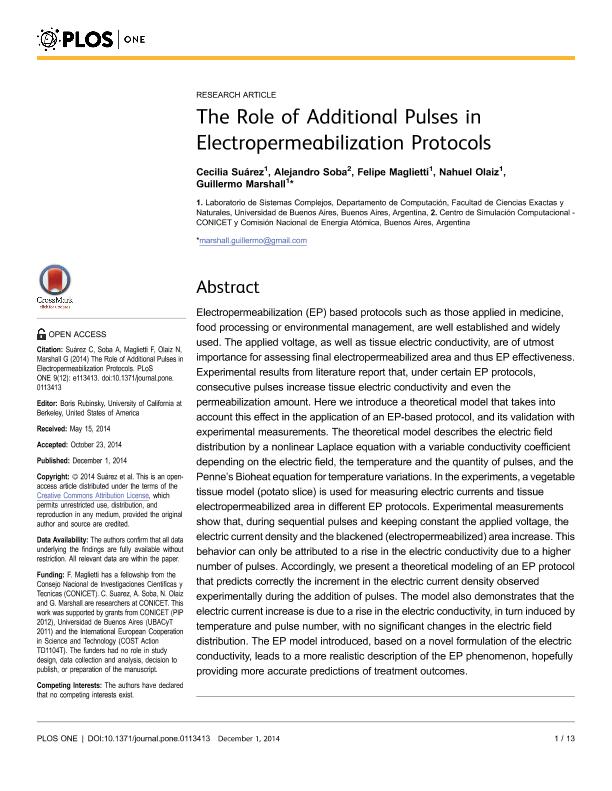Mostrar el registro sencillo del ítem
dc.contributor.author
Suárez, Cecilia Ana

dc.contributor.author
Soba, Alejandro

dc.contributor.author
Maglietti, Felipe Horacio

dc.contributor.author
Olaiz, Nahuel Manuel

dc.contributor.author
Marshall, Guillermo Ricardo

dc.date.available
2017-12-13T17:01:17Z
dc.date.issued
2014-12
dc.identifier.citation
Suárez, Cecilia Ana; Soba, Alejandro; Maglietti, Felipe Horacio; Olaiz, Nahuel Manuel; Marshall, Guillermo Ricardo; The Role of Additional Pulses in Electropermeabilization Protocols; Public Library of Science; Plos One; 9; 12; 12-2014; 1-13; e113413
dc.identifier.uri
http://hdl.handle.net/11336/30453
dc.description.abstract
Electropermeabilization (EP) based protocols such as those applied in medicine, food processing or environmental management, are well established and widely used. The applied voltage, as well as tissue electric conductivity, are of utmost importance for assessing final electropermeabilized area and thus EP effectiveness. Experimental results from literature report that, under certain EP protocols, consecutive pulses increase tissue electric conductivity and even the permeabilization amount. Here we introduce a theoretical model that takes into account this effect in the application of an EP-based protocol, and its validation with experimental measurements. The theoretical model describes the electric field distribution by a nonlinear Laplace equation with a variable conductivity coefficient depending on the electric field, the temperature and the quantity of pulses, and the Penne's Bioheat equation for temperature variations. In the experiments, a vegetable tissue model (potato slice) is used for measuring electric currents and tissue electropermeabilized area in different EP protocols. Experimental measurements show that, during sequential pulses and keeping constant the applied voltage, the electric current density and the blackened (electropermeabilized) area increase. This behavior can only be attributed to a rise in the electric conductivity due to a higher number of pulses. Accordingly, we present a theoretical modeling of an EP protocol that predicts correctly the increment in the electric current density observed experimentally during the addition of pulses. The model also demonstrates that the electric current increase is due to a rise in the electric conductivity, in turn induced by temperature and pulse number, with no significant changes in the electric field distribution. The EP model introduced, based on a novel formulation of the electric conductivity, leads to a more realistic description of the EP phenomenon, hopefully providing more accurate predictions of treatment outcomes.
dc.format
application/pdf
dc.language.iso
eng
dc.publisher
Public Library of Science

dc.rights
info:eu-repo/semantics/openAccess
dc.rights.uri
https://creativecommons.org/licenses/by-nc-sa/2.5/ar/
dc.subject
Electroporation
dc.subject
Additional Pulses
dc.subject
Permeabilization Area
dc.subject
Model
dc.subject.classification
Otras Ciencias Biológicas

dc.subject.classification
Ciencias Biológicas

dc.subject.classification
CIENCIAS NATURALES Y EXACTAS

dc.title
The Role of Additional Pulses in Electropermeabilization Protocols
dc.type
info:eu-repo/semantics/article
dc.type
info:ar-repo/semantics/artículo
dc.type
info:eu-repo/semantics/publishedVersion
dc.date.updated
2017-12-11T15:05:33Z
dc.identifier.eissn
1932-6203
dc.journal.volume
9
dc.journal.number
12
dc.journal.pagination
1-13; e113413
dc.journal.pais
Estados Unidos

dc.journal.ciudad
San Francisco
dc.description.fil
Fil: Suárez, Cecilia Ana. Universidad de Buenos Aires. Facultad de Ingeniería. Departamento de Computación. Laboratorio de Sistemas Complejos; Argentina. Consejo Nacional de Investigaciones Científicas y Técnicas; Argentina
dc.description.fil
Fil: Soba, Alejandro. Consejo Nacional de Investigaciones Científicas y Técnicas. Oficina de Coordinación Administrativa Parque Centenario. Centro de Simulación Computacional para Aplicaciones Tecnológicas; Argentina
dc.description.fil
Fil: Maglietti, Felipe Horacio. Universidad de Buenos Aires. Facultad de Ingeniería. Departamento de Computación. Laboratorio de Sistemas Complejos; Argentina. Consejo Nacional de Investigaciones Científicas y Técnicas; Argentina
dc.description.fil
Fil: Olaiz, Nahuel Manuel. Universidad de Buenos Aires. Facultad de Ingeniería. Departamento de Computación. Laboratorio de Sistemas Complejos; Argentina. Consejo Nacional de Investigaciones Científicas y Técnicas; Argentina
dc.description.fil
Fil: Marshall, Guillermo Ricardo. Universidad de Buenos Aires. Facultad de Ingeniería. Departamento de Computación. Laboratorio de Sistemas Complejos; Argentina. Consejo Nacional de Investigaciones Científicas y Técnicas; Argentina
dc.journal.title
Plos One

dc.relation.alternativeid
info:eu-repo/semantics/altIdentifier/doi/http://dx.doi.org/10.1371/journal.pone.0113413
dc.relation.alternativeid
info:eu-repo/semantics/altIdentifier/url/http://journals.plos.org/plosone/article?id=10.1371/journal.pone.0113413
Archivos asociados
